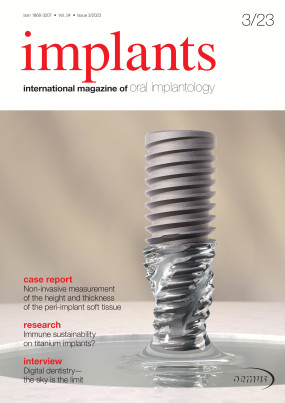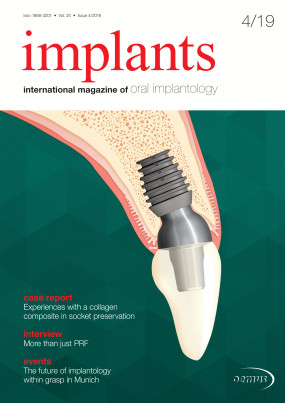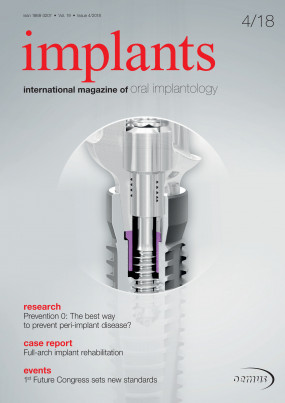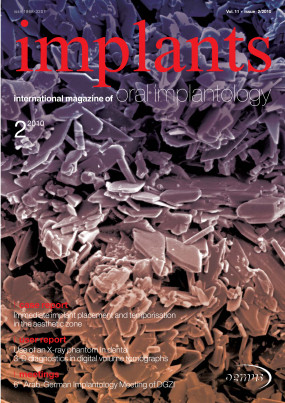Inhaltsverzeichnis
3
In celebration of the 50-year anniversary of the German Association of Dental Implantology (DGZI), its third Future Congress for Dental Implantology was held in Cologne in Germany in early October. Owing to coronavirus-related travel and other restrictions imposed by governments worldwide, we had to celebrate our anniversary with a delay of one year, but this did not hinder its success in any way. We can proudly look back on a beautiful and worthy celebration of half a century of European implantology and a multifaceted, exciting congress. All in all, this one- of-a-kind event did full justice to the unique occasion...
6
The last 30 years of world dentistry have undoubtedly been characterised by the exponential growth of im- plantology, which has gone from being a discipline in the hands of a few experts “to being a field of treatment at many dental practices. There are several reasons for this increase: firstly, surgical and prosthetic techniques have been simplified over the years, repeatable proto- cols being certified by decades of literature, reducing costs for the patient and limiting invasiveness and post-operative discomfort...
14
Dental implantology has become a fundamental com ponent of oral rehabilitation and is closely associated with prosthetic therapy. The aim of both implantology and prosthetics is to replace a lost natural tooth and to achieve restitutio ad integrum. To attain this goal, attempts have been made with different materials and techniques for many centuries. In the last few decades, metal implants in particular have established themselves extremely suc cessfully as an alternative to purely prosthetic therapies; however, the extent to which these may have a negative impact on the organism and the reasons for which they can lead to inflammatory reactions must be examined more closely.1, 2 ...
20
In order to achieve long-term stable results, it is important not to disregard biological principles. Bone and soft-tissue management should be an integral part of the portfolio of implantologists, since stable tissue is the basic prerequisite for implantological success. To this end, hard- and soft-tissue augmentation must be per- formed with materials adapted to the situation and indication. Another important factor is the choice of the implant system, because this can also be decisive for whether the bone level is maintained. Conical internal connections are therefore recommended, as they ensure the necessary stability of the abutment...
24
Sinus augmentation and simultaneous implant placement
Drs Fernando Duarte, Carina Ramos, Paulo Veiga & Marco Infante da Câmara, Portugal
The posterior sector of the maxilla consists of an extremely thin facial lamina, with the underlying trabecular bone having a low mineral content. The loss of maxillary posterior teeth is a typical bone resorption pattern that implies a decrease in the bone width available at the expense of the labial plate.1 This is the explanation why the width in the posterior sector of the maxilla decreases at a faster rate compared to other regions.2 It should also be noted that the lack of vascularisation accelerates the phenomenon of bone resorption and initial Class D3 or D4 trabecular bone. Even if it decreases by 60%, however, the residual ridge is wide enough in the posterior maxilla for root-form implants. Progressive resorption shifts the alveolar crest towards the palate at the expense of bone width.3 The posterior maxilla continues to atrophy until the entire alveolus is ablated to basal bone...
27
Long-term stable results are what every dentist should strive for with his work. Patients trust us and pay a lot of money when it comes to implanto- logical rehabilitation. Many problems in implantology are home-made because biological principles are disregarded...
30
he second most common dental agenesis is that of the maxillary lateral incisors, after agenesis of the mandibular third molars.1 This common agenesis has important functional and aesthetic impacts for the patient and is challenging to manage for the dental professional. Several approaches to address this condition, both for unilateral and bilateral, have been reported. From least to most in- vasive, these are (1) the conservative or prosthetic adap- tation of the canine to replace the incisor and of the first premolar for canine function (with or without orthodon- tic assistance); (2) the orthodontically assisted creation of space for the incisor and prosthetic replacement with a fixed prosthesis (employing several approaches); and (3) the orthodontically assisted creation of space for the incisor and implant-supported fixed rehabilitation; removable prosthetic rehabilitation can also be used, but only for provisional necessity when a fixed provisional prosthesis can- not be used.2 ...
32
Immediate functional implants in the aesthetic zone of a heavy smoker
Dr Dr Branislav Fatori & Dr Inge Schmitz, Germany
Dental implant placement represents the most cost-effective and long-term solution for the replacement of missing teeth and it can be argued that dental implants have a high average life expectancy. Immediate or early implant loading procedures are well documented in cases of edentulous sites in the mandible and the maxilla. It is often diffi- cult to obtain good results in the anterior region and it is essential for practitioners to understand the anatomical basis for and the limitations of implant dentistry in the aesthetic zone. To achieve satisfactory implant survival rates, it is vital to have reproducible treatment protocols that reinforce individual expertise and help to achieve high treatment quality. To this end, the following factors should be taken into consideration: Prior to tooth extraction, immediate loading requires the careful selection of patients and a high level of patient compliance...
34
Fine dentistry and creative engineering go hand in hand
An interview with Dr Kai Zwanzig and Ric Donaca
Many problems in implantology are self-made because biological principles are disregarded. Bone and soft-tissue management should be firmly anchored in the implantologist’s portfolio, as stable tissues are the basic prerequisite for implantological success. With the new Stable Tissue Concept from Dr Kai Zwanzig, it is possible to preserve all structures to the maxi- mum, in which the implant system in particular plays a paramount role. The new K3Pro product line from Argon Dental offers the best prerequisites for this. In this interview, Dr Kai Zwanzig and Ric Donaca, Managing Director of Argon Dental, discuss the advantages of this system...
42
50 plus one years into the future—An anniversary congress for German implantology
Dr Georg Bach, Germany
“Everything had been perfectly prepared, but the little matter of a virus got in the way”—with this open- ing statement, the congress president of the German Association of Dental Implantology (DGZI) opened the third Future Congress for Dental Implantology, which took place on 1 and 2 October in Cologne in Germany. Indeed, last year’s 50th anniversary congress, which was planned to be held in the founding German city of Bremen, fell victim to the coronavirus...














































































